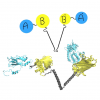Abstract
The transformation of a beautiful idea born via simulation into a commercial opportunity is described as it progresses from proof of concept towards a product. At the heart of this ongoing story is advanced simulation using massively parallel computation and rare-event methods.
Proof of concept : Metamorphosis
Author: Donal Makernan, University College Dublin, Ireland
Nervous excitement driven by optimism combined with a terrible foreboding – these are the sentiments that flow through one consciously and subconsciously as one waits to see if years of theoretical and simulation work will prove to be true when tested in experiment. In my case, the experiment was actually performed in living cells, where the diagnostic sensor we had designed, optimized, and validated in silico, was expressed by colleagues experts in molecular biology and genetic engineering. I was presented with the data in the form of graphs – and wept – it works. That was ten months ago. We had managed to do the experiment on a shoestring budget, a former head of the school and colleague contributing € 10,000 to fund an experimental postdoc for two months’ work, and I added another € 5,000 from my own pocket to pay for gene synthesis. The result suddenly changed dramatically how our invention was perceived – from an elegant idea that probably would not work in reality in the murky environment of living cells to something that works – but how wide is its scope of application? An industry consultant (who also is an expert in immunology) that I had worked with intensely on a number of proposals mentioned to a very successful investor what we had proven while they were working together on a different project. The investor, who can be characterized as a man of action, had been a pilot in the US air force, and worked for decades as an optico-electronic engineer in the US, Germany, and Switzerland, and later as an entrepreneur. Once he was convinced, he would move mountains to get something to work. Within three weeks of my receipt of his first email message, he had arrived in Dubin with a team for a week to discuss a possible agreement. Verbal commitments were made, and four weeks later, we had hired the first two members of the team, two software engineers (formerly theoretical physicists) to work on the project. So now, the challenge repeats itself, can we modify the design and build it as a sensor for the problem of our times, COVID 19? Technically, the problem is easier, but the time scale is much tighter. We need to have a sensor to market within four to five months. We have already been working for three months on the problem, and have a prototype design that we have been mutating selectively so as to optimize the performance of the sensor – and simulating the system on supercomputers including the seventh fastest in the world. Never have we had so much computational power at hand – thanks to E-CAM, CECAM, and PRACE – and we need that power if we are to reach our objective – the design, optimization and validation of sensors design through computer simulation. The typical complete system size is of the order of six million atoms, including the protein, target epitopes, water and salt representative of physiological conditions. To speed up the calculations we are using parallel replica exchange metadynamics, so that we can have multiple replicas exploring simultaneously the free energy landscape, thereby taking advantage of the fact that limited communication is needed between each replica (they update the same hills functions but otherwise they are essentially independent). To get convergence in sampling for the complete system in a reasonable human time of 3 days or so, we need 8 CPU nodes and 32 GPGPU’s. That said, as the sensor is in fact a modular protein, we focus on smaller parts of the system when we can, requiring greatly reduced computer resources. We are also developing a perturbative approach to speed up the simulation time, where we can compute free energy properties of an unperturbed system – and use that as the starting point for sampling the properties of the perturbed system.
It is important to stress the importance of our government funded university technology transfer office (TITO) in the commercialization aspects of this work. The scope of their support is wide, ranging from the filing of patent applications, negotiating licensing terms, to the incubation of start-up companies, training academic researchers on the basics of commercialization including the feasibility of bringing research ideas to market. While our research team is completely focused on developing further the scientific aspects of our work, the commercial and legal considerations are being largely handled by TITO case managers. They understood immediately that our invention is a platform technology, with a very wide range of applications. As a consequence, it was possible to commercialize specific fields of application ( COVID 19 and influenza A/B diagnostic sensors) with generous licensing terms, and using that to provide proof of concept to everything else, much as a farmer might sell a field to develop the rest of the farm.
In the next update of this blog, I hope to have news on the wet-lab validation of our COVID 19 sensors.


